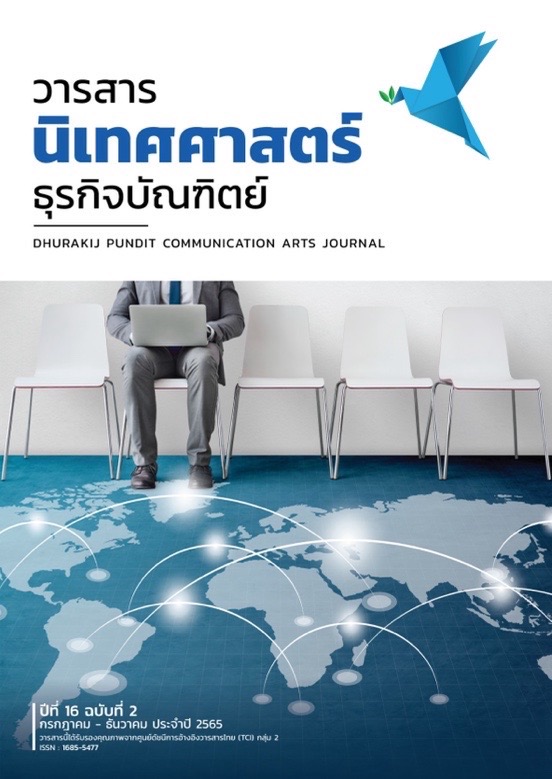การสื่อสารเพื่อการส่งเสริมการท่องเที่ยวเชิงวัฒนธรรมและอัตลักษณ์ช้างสุรินทร์
คำสำคัญ:
การสื่อสารเพื่อการส่งเสริม, การท่องเที่ยวเชิงวัฒนธรรม, อัตลักษณ์ช้างสุรินทร์บทคัดย่อ
งานวิจัยชิ้นนี้มีวัตถุประสงค์เพื่อ 1) เพื่อศึกษาคุณลักษณะของอัตลักษณ์ทางวัฒนธรรมและวิถีชุมชนช้างสุรินทร์ที่สื่อสารผ่านการท่องเที่ยวเชิงวัฒนธรรมและวิถีชุมชน 2) เพื่อศึกษารูปแบบการสื่อสารและการใช้สื่อในการส่งเสริมอัตลักษณ์ทางวัฒนธรรมและวิถีชุมชนช้างสุรินทร์ผ่านการท่องเที่ยวเชิงวัฒนธรรมและวิถีชุมชน 3) เพื่อศึกษาการรับรู้อัตลักษณ์ทางวัฒนธรรมช้างสุรินทร์และบทบาทของการท่องเที่ยวเชิงวัฒนธรรมและวิถีชุมชนที่มีต่อการสร้างการรับรู้คุณค่าอัตลักษณ์ช้างไทยในกลุ่มนักท่องเที่ยว 4) เพื่อพัฒนาแนวทางการสื่อสารเพื่อส่งเสริมการตระหนักในคุณค่าของช้างไทยผ่านการท่องเที่ยวเชิงวัฒธรรมและวิถีชุมชนช้างสุรินทร์ งานวิจัยนี้เป็นการวิจัยแบบผสมผสาน โดยวิธีวิจัยเชิงปริมาณเก็บข้อมูลแบบสอบถามจากนักท่องเที่ยวชาวไทย จำนวน 400 คน และวิธีวิจัยเชิงคุณภาพ ด้วยการสำรวจเอกสาร การสังเกตอย่างมีส่วนร่วม การสัมภาษณ์เชิงลึก และการสนทนากลุ่ม มีผู้ให้ข้อมูลจำนวน 31 คน ได้แก่ กลุ่มหมอช้าง คนในชุมชนเลี้ยงช้าง หน่วยงานภาครัฐและภาคเอกชนที่เกี่ยวข้อง
ผลการศึกษาในส่วนที่ 1 คุณลักษณะของอัตลักษณ์ทางวัฒนธรรมและวิถีชุมชนช้างสุรินทร์ พบว่า ด้านกระบวนการทางความคิดแห่งปัญญา มี 3 คุณลักษณะได้แก่ การคล้องช้าง พิธีเซ่นไหว้ผีปะกำ และผลิตภัณฑ์ท้องถิ่น ด้านวิถีชีวิต มี 2 คุณลักษณะ ได้แก่ ความผูกพันระหว่างคนกับช้างและประเพณีที่เกี่ยวข้องกับช้าง และด้านผลผลิตทางปัญญาและทางศิลปะ มี 26 คุณลักษณะ ได้แก่ ศูนย์คชศาสตร์ พิพิธภัณฑ์ช้าง คชอาณาจักร สุสานช้าง วัดป่าอาเจียง วังทะลุ ท่ารำเลียนแบบช้าง การแสดงรำคล้องช้าง สถาปัตยกรรมบ้านคนบ้านช้าง รูปปั้นพระครูปะกำ พิพิธภัณฑ์ครูปะกำช้าง บ้านโบราณพิพิธภัณฑ์ชาวกวย ศาลาช้างเอราวัณ กลุ่มทอผ้าไหมชาวกวย โรงเรียนฝึกช้าง ลานแสดงวัฒนธรรมของช้าง หอชมวิว โรงภาพยนตร์สามมิติ โรงช้างสำคัญ ศาลปะกำ พระพิฆเนศ โรงผลิตกระดาษสาจากมูลช้าง โฮมสเตย์ แกะสลักงาช้าง ภาษากวย การแต่งกายของชาวกวย
ผลการศึกษาในส่วนที่ 2 รูปแบบการสื่อสารและการใช้สื่อในการส่งเสริมอัตลักษณ์ทางวัฒนธรรมและวิถีชุมชนช้างสุรินทร์ พบว่า รูปแบบการสื่อสารและการใช้สื่อของชุมชน หน่วยงานภาครัฐและภาคเอกชน มีรูปแบบการสื่อสารปรากฏขึ้น 4 รูปแบบ คือ 1) รูปแบบการสื่อสารแบบทางเดียวที่มีลักษณะการสื่อสารแบบทางการ 2) รูปแบบการสื่อสารแบบทางเดียวที่มีลักษณะการสื่อสารแบบไม่ทางการ 3) รูปแบบการสื่อสารแบบสองทางที่มีลักษณะไม่เป็นทางการ 4) รูปแบบการสื่อสารแบบมีส่วนร่วม และการใช้สื่อเป็นลักษณะผสมผสานระหว่าง สื่อบุคคล สื่อเฉพาะกิจ สื่อมวลชน สื่ออินเทอร์เน็ต และสื่อประเพณี โดยมีทั้งที่ชุมชนผลิตสื่อเองและจากหน่วยงานภาครัฐภาคเอกชนสนับสนุนผลิตสื่อให้
ผลการศึกษาในส่วนที่ 3 การรับรู้อัตลักษณ์ทางวัฒนธรรมช้างสุรินทร์ต่อการสร้างคุณค่าอัตลักษณ์ช้างไทย พบว่า กลุ่มนักท่องเที่ยวส่วนใหญ่เปิดรับข้อมูลและตัดสินใจมาเที่ยวจากสื่อบุคคลมากที่สุด และเปิดรับจากบุคคลในครอบครัวมากที่สุด เหตุผลที่นักท่องเที่ยวเดินทางมาเที่ยวคือชมการแสดงช้างมากที่สุด และสัมผัสได้ว่าคนเลี้ยงช้างดูแลช้างได้เป็นอย่างดีมากที่สุด สิ่งที่ปรากฎในชุมชนเมื่อได้เข้าร่วมกิจกรรมคือเห็นวิถีชีวิตของชุมชนเลี้ยงช้างมากที่สุด ความเข้าใจของกลุ่มนักท่องเที่ยวในการสร้างการรับรู้คุณค่าอัตลักษณ์ช้างไทยโดยภาพรวมอยู่ในระดับมาก และคุณลักษณะการท่องเที่ยวเชิงวัฒนธรรมและอัตลักษณ์ช้างจังหวัดสุรินทร์โดยภาพรวมอยู่ในระดับมากที่สุด และการเสริมสร้างความเข้าใจและความตระหนักต่อการส่งเสริมให้เกิดคุณค่า อัตลักษณ์ช้างไทยของกลุ่มนักท่องเที่ยวโดยภาพรวมอยู่ในระดับมากที่สุด เมื่อเปรียบเทียบสถานที่ที่นักท่องเที่ยวเข้ามาหมู่บ้านช้าง ด้านการรับรู้คุณค่า คุณลักษณะ และความตระหนักต่อคุณค่าอัตลักษณ์ช้างไทย พบว่า นักท่องเที่ยวตระหนักต่อคุณค่าอัตลักษณ์ช้างไทยไม่แตกต่าง
ผลการศึกษาในส่วนที่ 4 แนวทางการสื่อสารเพื่อส่งเสริมการตระหนักในคุณค่าช้างไทย พบว่า ต้องใช้หลักของการท่องเที่ยวชุมชน ด้านทรัพยากรธรรมชาติและวัฒนธรรม ได้แก่ ช้าง วัฒนธรรมประเพณี ป่า น้ำ ด้านองค์กรชุมชน ได้แก่ ปราชญ์ชาวบ้าน หมอช้าง หน่วยงานภาครัฐและภาคเอกชน ด้านการจัดการ วัฒนธรรมและการท่องเที่ยวต้องมีกฎกติกาในการทำงาน กระจายรายได้และผลประโยชน์อย่างเป็นธรรม ด้านการเรียนรู้ กิจกรรมการท่องเที่ยวต้องสร้างความเข้าใจในวิถีชีวิตวัฒนธรรมจัดการให้เกิดการเรียนรู้ระหว่างชุมชนกับนักท่องเที่ยว สร้างจิตสำนึกในการท่องเที่ยวหมู่บ้านช้าง โดยกำหนดแนวทางการสื่อสารได้ดังนี้ 1) กำหนดวัตถุประสงค์ของการสื่อสาร กำหนดกลุ่มเป้าหมายของผู้รับสาร กำหนดรูปแบบของกิจกรรมการท่องเที่ยว 2) การใช้เครื่องมือการสื่อสาร ได้แก่สื่อบุคคล สื่อประเพณี สื่อมวลชน สื่ออินเทอร์เน็ต สื่อเฉพาะกิจ 3) การเลือกวิธีการสื่อสารให้สอดคล้องกับกลุ่มเป้าหมาย 4) การสร้างเครือข่ายการสื่อสาร 5) การสื่อสารแบบมีส่วนร่วม โดยเป็นผู้ร่วมคิด ร่วมตัดสินใจ ร่วมปฏิบัติ และร่วมติดตามประเมินผล
เอกสารอ้างอิง
กระทรวงการท่องเที่ยวและกีฬา. (2560). แผนพัฒนาการท่องเที่ยวแห่งชาติ ฉบับที่ 2 (พ.ศ. 2560-2564). สำนักงานปลัดกระทรวงการท่องเที่ยวและกีฬา. https://www.ubu.ac.th/web/files_up/03f2017052216244626.pdf
กาญจน์นภา พงศ์พนรัตน์. (2563). มาตรฐานการท่องเที่ยวที่เกี่ยวข้อง Sustainable tourism criteria. วิทยาลัยนวัตกรรม มหาวิทยาลัยธรรมศาสตร์.
กาญจนา แก้วเทพ, และ สมสุข หินวิมาน. (2560). สายธารแห่งนักคิด ทฤษฏีเศรษฐศาสตร์การเมืองกับสื่อสารศึกษา. อินทนิล.
จินตวีร์ เกษมศุข. (2557). หลักการมีส่วนร่วมกับการพัฒนาชุมชนอย่างยั่งยืน. จุฬาลงกรณ์มหาวิทยาลัย.
ฐิตินัน บุญภาพ คอมมอน. (2565). สื่อดิจิทัลกับเยาวชน: ตัวตน อัตลักษณ์และความเป็นพลเมือง.จุฬาลงกรณ์มหาวิทยาลัย.
ทวีศักดิ์ ทองทิพย์, เศรษฐพร หนุนชู, ปัญวลี เสริมทรัพย์, พระมหาโชตนิพิฐพนธ์ สุทธจิตโต (ผลเจริญ), และ ธนู ศรีทอง. (2561). ศาสนาและวัฒนธรรม: การใช้ประโยชน์จากอัตลักษณ์ของฐานทรัพยากรการท่องเที่ยวจังหวัดสุรินทร์. วารสารวิชาการ มจร.บุรีรัมย์, 6(1), 91-104. https://so06.tci-thaijo.org/index.php/ambj/article/view/247030/168628
เธียรชัย อิศรเดช. (2552). อัตลักษณ์กับสื่อ : ตัวตนกับการสื่อสาร. นิเทศศาสตรปริทัศน์ มหาวิทยาลัยรังสิต, 13(1), 25-29.
บุญชม ศรีสะอาด, ลัดดา สำรองพันธ์, มนทิยา ลีประโคน, และวุฒิไกร ป้อมมะรัง. (2562). การศึกษาวิถีชีวิตช้างศูนย์คชศึกษาบ้านตากลาง ตำบลกระโพ อำเภอท่าตูม จังหวัดสุรินทร์ ประเทศไทย. วารสารศึกษาศาสตร์ มหาวิทยาลัยมหาสารคาม, 13(2), 173-186. http://edu.msu.ac.th/journal/home/journal_file/595.pdf
ปฐมภรณ์ จันทร์แก้ว. (2555). การสื่อสารเพื่อการอนุรักษ์ศิลปวัฒนธรรมและฟื้นฟูการท่องเที่ยวของตลาดสามชุก จังหวัดสุพรรณบุรี [วิทยานิพนธ์ปริญญามหาบัณฑิต, มหาวิทยาลัยธุรกิจบัณฑิตย์]. ศูนย์เรียนรู้และหอสมุด มหาวิทยาลัยธุรกิจบัณฑิตย์. http://libdoc.dpu.ac.th/thesis/144687.pdf
โปรดปราน รังสิมันตุชาติ. (2557). การสื่อสารเพื่อส่งเสริมการท่องเที่ยวเชิงอนุรักษ์ของศูนย์อนุรักษ์ช้างไทย จังหวัดลำปาง [วิทยานิพนธ์ปริญญามหาบัณฑิต, มหาวิทยาลัยธุรกิจบัณฑิตย์]. ศูนย์เรียนรู้และหอสมุด มหาวิทยาลัยธุรกิจบัณฑิตย์. http://libdoc.dpu.ac.th/thesis/152812.pdf
ภูวดล สุวรรณบุตร. (2560). โครงการออกแบบสื่อวัฒนธรรมเกี่ยวกับช้างของชาวกวย จังหวัดสุรินทร์ [วิทยานิพนธ์ปริญญามหาบัณฑิต, มหาวิทยาลัยศิลปากร]. มหาวิทยาลัยศิลปากร http://ithesis-ir.su.ac.th/dspace/bitstream/123456789/1353/1/58156321.pdf
รพีพรรณ จันทับ, และ ลินจง โพชารี. (2559). ปัจจัยด้านอัตลักษณ์ทรัพยากรท่องเที่ยวที่มีผลต่อความสำเร็จในการจัดการการท่องเที่ยวหมู่บ้านช้างบ้านตากลาง จังหวัดสุรินทร์. WMS Journal of Management, Walalilak University, 5(1), 48-59. https://so06.tci-thaijo.org/index.php/wms/article/view/47202/39107
รุ่งรัตน์ หัตถกรรม. (2560). การท่องเที่ยวชุมชน. สาขาการท่องเที่ยวและการโรงแรม, คณะวิทยาการจัดการ มหาวิทยาลัยราชภัฏบุรีรัมย์.
วิรัญชนา ใจสม. (2560). การศึกษาปัจจัยการรับรู้สื่อสังคมออนไลน์ที่ส่งผลต่อการตัดสินใจเดินทางท่องเที่ยวของนักท่องเที่ยวชาวไทย [การค้นคว้าอิสระปริญญามหาบัณฑิต, มหาวิทยาลัยกรุงเทพ]. มหาวิทยาลัยกรุงเทพ. http://dspace.bu.ac.th/bitstream/123456789/2923/1/wirunchana_jais.pdf
ศศลักษณ์ พอลลาร์ด. (2560). การมีส่วนร่วมของชุมชนต่อแหล่งท่องเที่ยวเชิงวัฒนธรรม หมู่บ้านช้าง บ้านตากลาง ต.กระโพ อ.ท่าตูม จ.สุรินทร์ [วิทยานิพนธ์ปริญญามหาบัณฑิต, มหาวิทยาลัยกรุงเทพ]. มหาวิทยาลัยกรุงเทพ. http://dspace.bu.ac.th/handle/123456789/2921
ศศิกานต์ สังข์ทอง. (2562). การบูรณาการการสื่อสารสื่อพื้นบ้านกับสื่อใหม่เพื่อส่งเสริมและพัฒนาวัฒนธรรมผ้าย้อมครามจังหวัดสกลนคร [ปริญญานิพนธ์ปริญญาดุษฎีบัณฑิต, มหาวิทยาลัยธุรกิจบัณฑิตย์]. ศูนย์เรียนรู้และหอสมุด มหาวิทยาลัยธุรกิจบัณฑิตย์. http://libdoc.dpu.ac.th/thesis/Sasikarn.Sun.pdf
สำนักงานเลขานุการคณะกรรมการยุทธศาสตร์ชาติ สำนักงานคณะกรรมการพัฒนาการเศรษฐกิจและสังคมแห่งชาติ. (2561). แผนแม่บทภายใต้ยุทธศาสตร์ชาติ (5) ประเด็นการท่องเที่ยว (พ.ศ. 2561-2580). https://bit.ly/3d9FDjc
สำนักเศรษฐกิจท่องเที่ยวและกีฬา. (2559). รายงานฉบับสมบูรณ์ (Final Report) โครงการทิศทางการพัฒนาการท่องเที่ยวของประเทศไทยในระยะ 10 ปี. เอฟฟินิตี้. https://secretary.mots.go.th/ewtadmin/ewt/policy/article_attach/02FinalReportDirection10Year.pdf
สุดถนอม ตันเจริญ. (2561). การจัดการการท่องเที่ยวโดยชุมชนกับการพัฒนาการท่องเที่ยวอย่างยั่งยืนของชุมชนบางขันแตก จังหวัดสมุทรสงคราม. วารสารวิชาการมหาวิทยาลัยราชภัฏเพชรบุรี, 8(2), 32-41. https://journal.pbru.ac.th/admin/upload/article/1539-2019-06-25.pdf
องค์การบริหารส่วนจังหวัดสุรินทร์. (2561). กำเนิดโลกของช้าง. ผู้แต่ง.
MGR Online. (2560, 6 ตุลาคม). ชูธุรกิจปางช้างรูปแบบใหม่ เน้นเป็นมิตรต่อช้าง มากกว่าเสพความบันเทิงจากช้าง. MGR Online. https://mgronline.com/travel/detail/
ดาวน์โหลด
เผยแพร่แล้ว
ฉบับ
ประเภทบทความ
สัญญาอนุญาต
ลิขสิทธิ์ (c) 2022 วารสารนิเทศศาสตร์ธุรกิจบัณฑิตย์

อนุญาตภายใต้เงื่อนไข Creative Commons Attribution-NonCommercial-NoDerivatives 4.0 International License.
ลิขสิทธิ์เป็นของวารสาร....




